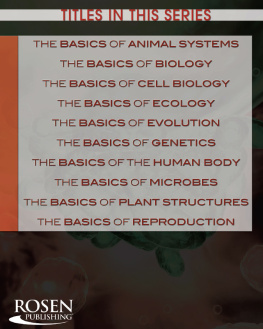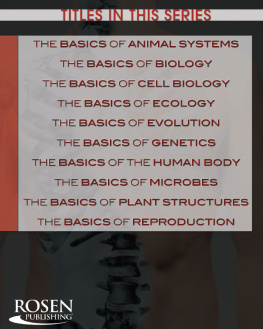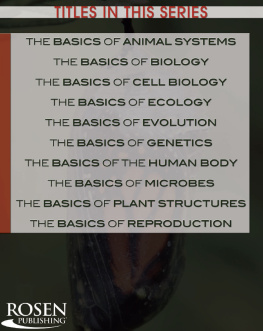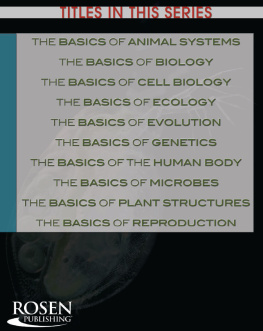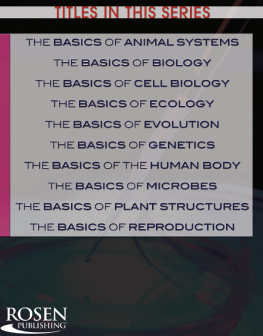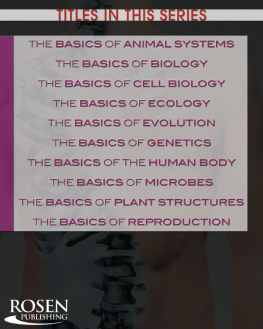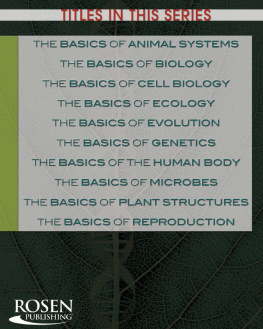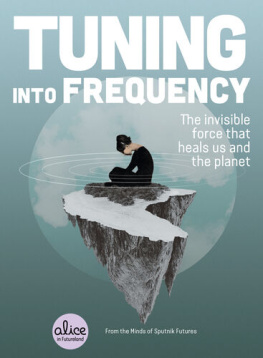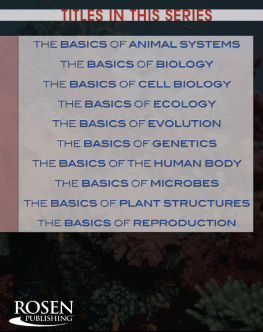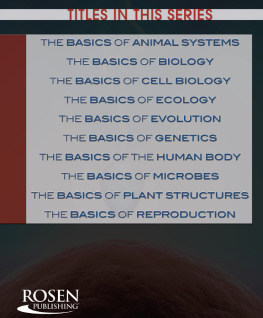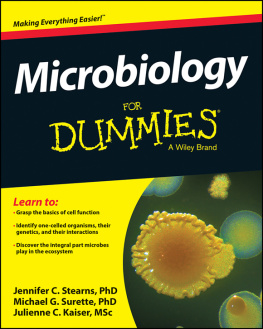This edition published in 2014 by:
The Rosen Publishing Group, Inc.
29 East 21st Street
New York, NY 10010
Additional end matter copyright 2014 by The Rosen Publishing Group, Inc.
All rights reserved. No part of this book may be reproduced in any form without permission in writing from the publisher, except by a reviewer.
Library of Congress Cataloging-in-Publication Data
Wanjie, Anne.
The basics of microbes/Anne Wanjie.1st ed.New York:
Rosen, 2014
p. cm.(Core concepts)
Includes bibliographical references and index.
ISBN 978-1-4777-0550-6 (library binding)
1. MicroorganismsJuvenile literature. I. Title.
QR57 .W36 2014
Manufactured in the United States of America
CPSIA Compliance Information: Batch #S13YA: For further information, contact Rosen Publishing, New York, New York, at 1-800-237-9932.
2004 Brown Bear Books Ltd.
CONTENTS
CHAPTER 1: MICROSCOPIC LIFE
CHAPTER 2: WHAT ARE BACTERIA?
CHAPTER 3: WHAT ARE PROTISTS?
CHAPTER 4: WHAT ARE VIRUSES?
CHAPTER 5: THE CONNECTION BETWEEN MICROORGANISMS AND DISEASE
CHAPTER 6: USEFUL MICROORGANISMS
CHAPTER 7: BIOGRAPHY: LOUIS PASTEUR
GLOSSARY
FOR MORE INFORMATION
FOR FURTHER READING
INDEX
CHAPTER ONE
MICROSCOPIC LIFE
Microorganisms matter. Although we cannot see them without using a microscope, billions of microorganisms live all around uson land, sea, and even deep underground.
M icroorganisms live in all extremes, from near-boiling volcanic springs to frozen polar ice, and from high mountain peaks to ocean trenches. They also live on and in all plants and animals. Microorganisms are often simple life forms, but they are essential to life on Earth.
The main types of microorganisms are bacteria and protists. Bacteria are singlecelled organisms. People often think of them as dangerous and disease-causing, but most are not harmful. Many types of bacteria break down dead organic matter, including food inside peoples stomachs.
Rotting grapes. Bacteria cause the fruit to rot and decompose. The visible signs of mold on the surface of the grapes are the fruiting bodies of a parasitic fungus growing inside the fruit.
THE BASICS OF MICROORGANISMS
A microorganism is any life form so small that you cannot see it without a powerful microscope. The word is used most commonly to refer to single-celled organisms that belong to two main groups: the bacteria and the protists. Viruses, although they are not cells, may also be included, as well as some microscopic fungi such as yeasts. The study of microorganisms is called microbiology.
Protists include green algae, amebas, slime molds, and many types of plankton (floating organisms). The group is very diverse and includes many organisms that are related only distantly. Some protists move around like tiny animals. Others seem more like plants. Yet others are plantlike and animal-like at various stages in their life.
Diatoms are single-celled organisms that live in oceans. They have complex shapes formed by glassy skeletons with beautiful patterns.
WHY ARE MICROORGANISMS IMPORTANT?
Some microorganisms cause terrible diseases such as tuberculosis and AIDS. Yet overall, we cannot do without them. They are vital to all Earths ecosystems, and life would be impossible without them.
Microorganisms are too small to see with the naked eye, so it is not always obvious how important they are. They play many different roles. Some microorganisms make their own food, as plants do. Others hunt prey, as animals do, while yet others rot down and recycle dead material. Plantlike microorganisms that float in the oceans are particularly important. Just like true plants, they use the energy in sunlight to turn water and carbon dioxide from the air into food and oxygen by photosynthesis. These microorganisms are eaten by others and form the base of a food chain that leads to fish, whales, and even people. Many single-celled protists are plantlike. Plantlike protists are often called algae, or microalgae if they are single-celled. Not all the microorganisms called algae are related closely.
AN INTERESTING DISCOVERY
In the 1700s the Dutch microscope-maker Anton van Leeuwenhoek (16321723) was the first person to see and describe many bacteria and protists. Detailed understanding of these life forms came much later, however. In the 19th century the French scientist Louis Pasteur (18221895) proved that rotting and fermentation processes were caused by microorganisms and provided strong evidence that they also caused disease.
Bacteria were first proved to cause diseases in humans and other animals by the German physician Robert Koch (18431910) in 1880. A better understanding of viruses, which are much smaller than bacteria, had to wait until the 20th century.
MICROSCOPIC COOPERATION
Microorganisms often team up with other living things in relationships called symbioses. Sometimes one partner is a parasite or a smaller creature that hitches a ride on a larger one. Often two creatures form a mutually beneficial relationship called a mutualism. For example, cattle have microorganisms in their gut that help them digest their tough plant food. The microorganisms get a safe home in return. Corals (right) are tiny animals that live in colonies and form coral reefs. They share a mutualism with single-celled algae in their tissues that supply them with much of their food.
BY-PRODUCTS
Some microorganismsespecially bacteriaare vital to the cycling of elements such as carbon and nitrogen through ecosystems. Although they are tiny and simple compared to animals and plants, bacteria are natures experts at carrying out certain chemical reactions. For example, during the process called nitrogen fixation some bacteria in the soil and on the roots of plants take nitrogen from the air. They turn it into compounds that are used by plants. Plants could not grow without these bacteria.
LIFE IN EXTREME CONDITIONS
Microorganisms live everywhere on Earth, including some very extreme or dicult environments where other organisms cannot survive, such as places where there is no oxygen. Some bacteria live in water that is boiling hot or extremely salty. Others feed off chemicals that are poisonous to other organisms.
Most life on Earth is based on energy from the sun. Hydrothermal vents are hot-water channels on the deep ocean floor. There, sulfur-using bacteria form the base of a food web that does not depend on sunlight at all.
The bacteria trap chemical energy from sulfides in the hot water that gushes from the vents just as plants do from sunlight. Other microorganisms live in less harsh environments but need to be able to survive occasional hard times. Many form a thick wall around themselves when they need to survive unfavorable conditions.

